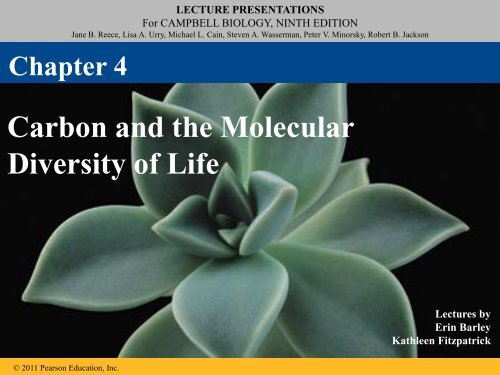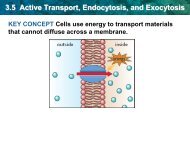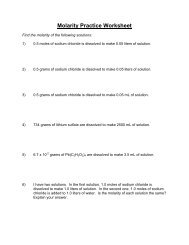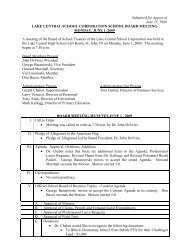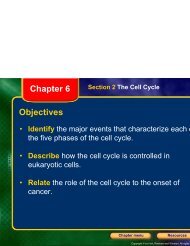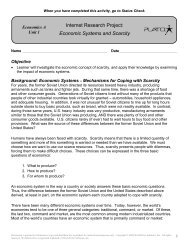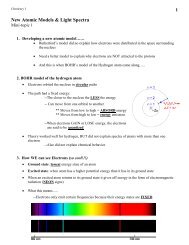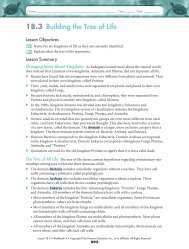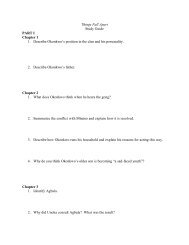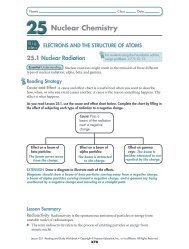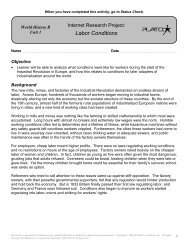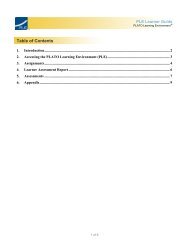Chapter 4 Notes
Chapter 4 Notes
Chapter 4 Notes
- No tags were found...
You also want an ePaper? Increase the reach of your titles
YUMPU automatically turns print PDFs into web optimized ePapers that Google loves.
LECTURE PRESENTATIONSFor CAMPBELL BIOLOGY, NINTH EDITIONJane B. Reece, Lisa A. Urry, Michael L. Cain, Steven A. Wasserman, Peter V. Minorsky, Robert B. Jackson<strong>Chapter</strong> 4Carbon and the MolecularDiversity of LifeLectures byErin BarleyKathleen Fitzpatrick© 2011 Pearson Education, Inc.
Overview: Carbon: The Backbone of Life• Living organisms consist mostly of carbon-basedcompounds• Carbon is unparalleled in its ability to form large,complex, and diverse molecules• Proteins, DNA, carbohydrates, and othermolecules that distinguish living matter are allcomposed of carbon compounds© 2011 Pearson Education, Inc.
Figure 4.1We findCarboneverywhere innature
Concept 4.1: Organic chemistry is the studyof carbon compounds• Organic chemistry is the study of compoundsthat contain carbon• Organic compounds range from simplemolecules to colossal ones• Most organic compounds contain hydrogenatoms in addition to carbon atoms© 2011 Pearson Education, Inc.
Organic Molecules and the Origin of Lifeon Earth• Stanley Miller’s classic experimentdemonstrated the abiotic synthesis oforganic compounds• Experiments support the idea that abioticsynthesis of organic compounds, perhapsnear volcanoes, could have been a stage inthe origin of life© 2011 Pearson Education, Inc.
Figure 4.2EXPERIMENTWater vaporCH 4―Atmosphere‖ElectrodeCondenserCooled ―rain‖containingorganicmoleculesColdwaterH 2 O―sea‖Sample for chemical analysis
The Formation of Bonds with Carbon• With four valence electrons, carbon can formfour covalent bonds with a variety of atoms• This ability makes large, complex moleculespossible• In molecules with multiple carbons, each carbonbonded to four other atoms has a tetrahedralshape• Carbon can form single, double, or triple bonds.© 2011 Pearson Education, Inc.
Figure 4.3Name andCommentMolecularFormulaStructuralFormulaBall-and-Stick ModelSpace-FillingModel(a) MethaneCH 4(b) EthaneC 2 H 6(c) Ethene(ethylene)C 2 H 4
Molecular Diversity Arising from CarbonSkeleton Variation• Carbon chains form the skeletons of mostorganic molecules• Carbon chains vary in length and shapeAnimation: Carbon Skeletons© 2011 Pearson Education, Inc.
Figure 4.5(a) Length(c) Double bond positionEthanePropane1-Butene2-Butene(b) Branching(d) Presence of ringsButane2-Methylpropane(isobutane)CyclohexaneBenzene
Hydrocarbons• Hydrocarbons are organic moleculesconsisting of only carbon and hydrogen• Many organic molecules, such as fats, havehydrocarbon components• Hydrocarbons can undergo reactions thatrelease a large amount of energy© 2011 Pearson Education, Inc.
Figure 4.6NucleusFat droplets10 m(a) Part of a human adipose cell(b) A fat molecule
Isomers• Isomers are compounds with the samemolecular formula but different structures andproperties– Structural isomers have different covalentarrangements of their atoms– Cis-trans isomers have the same covalentbonds but differ in spatial arrangements– Enantiomers are isomers that are mirrorimages of each otherAnimation: Isomers© 2011 Pearson Education, Inc.
Figure 4.7(a) Structural isomers(b) Cis-trans isomerscis isomer: The two Xsare on the same side.trans isomer: The two Xsare on opposite sides.(c) EnantiomersCO 2 HCO 2 HH NH 2CH 3L isomerNH 2CH 3HD isomer
• Enantiomers are important in thepharmaceutical industry• Two enantiomers of a drug may have differenteffects• Usually only one isomer is biologically active• Differing effects of enantiomers demonstratethat organisms are sensitive to even subtlevariations in moleculesAnimation: L-Dopa© 2011 Pearson Education, Inc.
Figure 4.8DrugConditionEffectiveEnantiomerIneffectiveEnantiomerIbuprofenPain;inflammationS-IbuprofenR-IbuprofenAlbuterolAsthmaR-AlbuterolS-Albuterol
The Chemical Groups Most Important inthe Processes of Life• Functional groups are the components oforganic molecules that are most commonlyinvolved in chemical reactions• The number and arrangement of functionalgroups give each molecule its uniqueproperties© 2011 Pearson Education, Inc.
Figure 4.UN02EstradiolTestosterone
• The seven functional groups that are mostimportant in the chemistry of life:– Hydroxyl group– Carbonyl group– Carboxyl group– Amino group– Sulfhydryl group– Phosphate group– Methyl group© 2011 Pearson Education, Inc.
Figure 4.9-aCHEMICALGROUPHydroxylCarbonylCarboxylSTRUCTURE(may be written HO—)NAME OFCOMPOUNDAlcohols (Their specific namesusually end in -ol.)Ketones if the carbonyl group iswithin a carbon skeletonCarboxylic acids, or organic acidsAldehydes if the carbonyl groupis at the end of the carbon skeletonEXAMPLEEthanolAcetoneAcetic acidPropanalFUNCTIONALPROPERTIES• Is polar as a result of theelectrons spending more timenear the electronegative oxygenatom.• Can form hydrogen bonds withwater molecules, helping dissolveorganic compounds such assugars.• A ketone and an aldehyde may bestructural isomers with differentproperties, as is the case foracetone and propanal.• Ketone and aldehyde groups arealso found in sugars, giving riseto two major groups of sugars:ketoses (containing ketonegroups) and aldoses (containingaldehyde groups).• Acts as an acid; can donate anH + because the covalent bondbetween oxygen and hydrogenis so polar:NonionizedIonized• Found in cells in the ionized formwith a charge of 1 and called acarboxylate ion.
Figure 4.9-bAmino Sulfhydryl Phosphate Methyl(may bewritten HS—)AminesThiolsOrganic phosphatesMethylated compoundsGlycineCysteineGlycerol phosphate5-Methyl cytidine• Acts as a base; canpick up an H + from thesurrounding solution(water, in livingorganisms):Nonionized• Found in cells in theionized form with acharge of 1+.Ionized• Two sulfhydryl groups canreact, forming a covalentbond. This ―cross-linking‖helps stabilize proteinstructure.• Cross-linking of cysteinesin hair proteins maintainsthe curliness or straightnessof hair. Straight hair can be―permanently‖ curled byshaping it around curlersand then breaking andre-forming the cross-linkingbonds.• Contributes negative charge tothe molecule of which it is a part(2– when at the end of a molecule,as above; 1– when locatedinternally in a chain ofphosphates).• Molecules containing phosphategroups have the potential to reactwith water, releasing energy.• Addition of a methyl groupto DNA, or to moleculesbound to DNA, affects theexpression of genes.• Arrangement of methylgroups in male and femalesex hormones affects theirshape and function.
ATP: An Important Source of Energy forCellular Processes• One phosphate molecule, adenosinetriphosphate (ATP), is the primary energytransferringmolecule in the cell• ATP consists of an organic molecule calledadenosine attached to a string of threephosphate groups© 2011 Pearson Education, Inc.
Figure 4. UN05AdenosineReactswith H 2 OAdenosineEnergyATPInorganicphosphateADP


